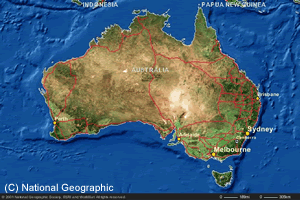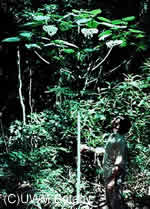
- There are 6 species within this genus, 2 of which are actually trees (D. excelsa-the Giant Stinging Tree, and D. photinophylla, the Shiny Leaf Stinging Tree), and 4 are shrubs (D. moroides, the Gympie-Gympie, and D. cordifolia); all are locally referred to as "Stingers"
- They are mostly found along Australia's eastern coast, especially in the rainforest of the northeast (Queensland)
- Like other nettles, they tend to grow in disturbed areas, especially forest clearings and riverbanks (Hurley, 2000) ("Moonlighter...")
- The Giant Stinging Tree can grow up to 40m (~130ft) in height, while the shrub species only reach 1-2m (3-7ft) ("Contact Urticaria") ("Moonlighter...")
- They have broad, heart-shaped leaves as big as dinner plates, which are quickly regrown after being damaged/eaten
- Like other nettles, they are covered with thousands of tiny stinging hairs, even on the fruits; the larger trees, however, usually don't have hairs on their trunks
- Many animals feed on the leaves and fruits of the stinging trees, including spiders, scarab beetles, green ants, mites, katydids, sapsuckers, leaf hoppers, assassin bugs, snails, frogs, lizards and birds; the worst herbivores are the shiny green-black beetle (Prasyptera mastersi) and the redlegged pademelon (Thylogal stigmatica) (a small wallaby) (Hurley, 2000)
The Sting:
- The sting of Dendrocnide is far worse than any species of Urtica ("Contact Urticaria"); they have been known to kill dogs and horses that have bumped into them, and there are stories of human fatalities, but with only one official death (Hurley, 2000) (Everist, 732)
- Marina Hurley, a leading researcher of stinging trees, found that the only way she could handle the plant to study it was with heavy welding gloves
- A military officer supposedly shot himself to be rid of the pain of the sting, and another had to be restrained in his hospital bed for three weeks (Hurley, 2000)
- On the cellular level, one study concluded that the chemicals acted like Acetylcholine, Histamine, and Serotonin, but were actually different chemicals ("Moonlighter...") (Everist, 730); not enough research has been done on this topic
- The hairs are often so small that the skin closes over them, and any contact or hot or cold temperatures on the site can be painful for up to a year after the initial sting (Hurley, 2000)
- In addition, the toxin doesn't seem to be affected by time or by heat; samples that have been in museums for decades can still sting ("Moonlighter...")
- The best first aid that has been found is to apply wax hair-removal strips at room temperature and then yank them off to remove the hairs (Hurley, 2000)
- Chopping and slashing of the plants can cause excessive sneezing and intense throat irritation (Everist, 731); Australian forestry workers carry gloves, respirators, and antihistamines to prevent this ("Moonlighter...")
- D. moroides is definitely the most virulent of all the species ("Moonlighter...") (Everist, 733)


© Copyright 2001 Department of Biology,
Davidson College, Davidson, NC 28036. Send comments, questions, and suggestions
to: kabernd@davidson.edu

